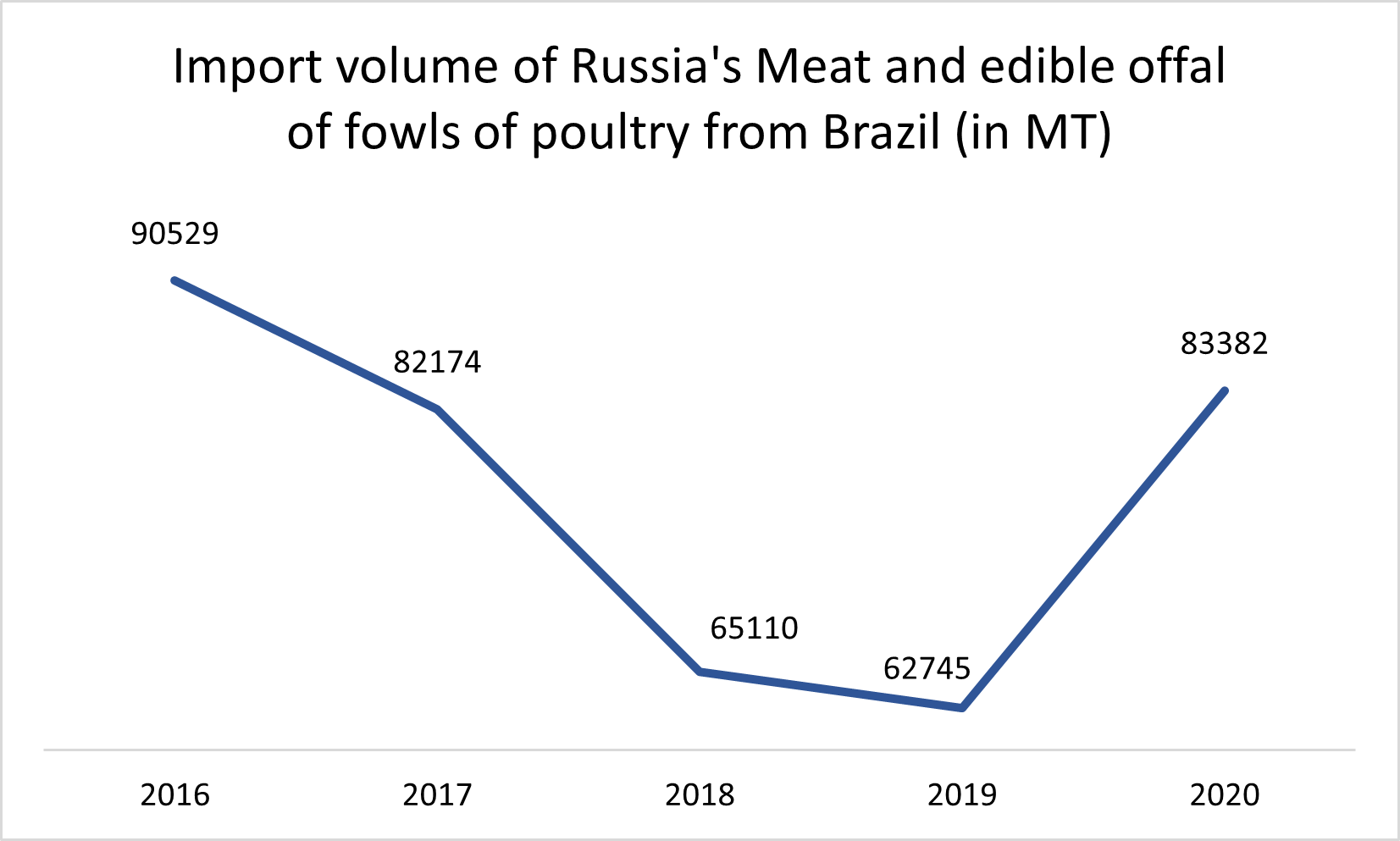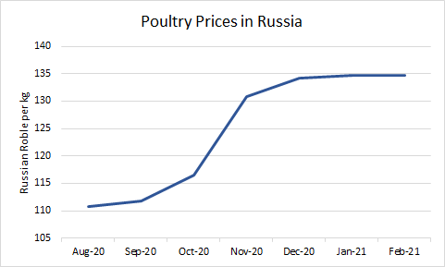Chickens flying high in prices in Russia
On March 2, Reuters reported that the Russian government may opt to significantly cut import tax imposed on Brazilian poultry to ease rising food prices if other proposals are declared insufficient. Some of these other proposals were to increase the ceiling amount for subsidies and to delay the loan payback period for Russian poultry producers. Prior to this, the Russian government has already restricted grain exports to manage the alarming food inflation.
Poultry demand in Russia
Russians have had a relatively big appetite for meat, consuming 62.6 kg per capita and among its different types, poultry meat has been the most consumed, triple that of beef and veal based on OECD data in 2019. On top of being a prominent consumer and the world’s fourth-largest poultry producer, it is also the third-largest importer, with 30% of imports sourced from Brazil, based on 2019 data. From 2016 to 2019, Russia’s poultry imports from Brazil have declined mainly due to the “Weak Flesh Operation” where Brazilian politicians and inspection authorities were found to receive bribery in exchange for approving meat unfit for sale and export. In 2020, 83,382 MT of poultry has been imported from Brazil which was a huge leap from the lowest point in 2019 within the last 5 years. For 2021, Russia was allotted 364,000 MT of poultry import quota from Brazil free from import tax but any amount beyond the quota is to be imposed with up to 65% import tax.

Source: ITC Trade Data, Tridge
Factors behind rising poultry prices
Globally, food prices have been on the rise, restraining the consumption basket of consumers. Russia was not excused wherein it experienced a 7.7% rise in food prices over 2020. Undoubtedly, poultry prices also jumped. A kilogram of poultry meat that started at RUB 110 back in August 2020 rose by 22% to RUB 135 in just five months’ time. This has greatly constricted the food budget of Russian consumers especially with poultries such as chicken meat and eggs serving as their most consumed animal protein.

Source: index mundi, Tridge
The rising poultry prices can be attributed to two main factors, namely the bird flu outbreak and the ever-rising feed prices.
The bird flu, or avian influenza, has brought down both global demand and supply wherein fears of contracting the H5N8 virus reduced consumption and caused mass slaughtering of poultry birds worldwide. The situation is worse for Russia as it recently reported the world’s first avian virus infection in humans after an outbreak in southern Russia last December 2020, making consumers more conscious of the origin of poultry meat. Countries around the world have culled paramount numbers of chickens to contain the virus, causing an abrupt and significant disruption in the supply chain.
Rising feed prices are another key factor with corn and soybeans at the forefront of the issue. Corns and soybeans are the major grains used as feeds, and their prices have been surging due to poor harvest from drought and export bans from key supplying countries. Due to the fear of domestic shortage along with Covid-19, countries including Russia, temporarily banned exports of grains during the first few months of the outbreak, further pushing prices upwards and consequently increasing the cost of raising chickens. For example, in Brazil, the cost of raising chickens rose by 39% during 2020 compared to the previous year. Although Russians domestically produce grains, due to the nature of grains as commodities, their prices are linked to export prices wherein domestic grain prices increase along with rising global grain prices. This then equally causes pain in its domestic market. Moreover, the devaluation of the Russian Roble weakened the purchasing power of Russian poultry producers for grains, adding to their financial constraints.
Outlook
Overall, Russia is expected to continue to suffer from high poultry prices due to avian influenza and rising grain prices. These problems will directly affect the supply chain within and outside Russia for a substantial amount of time. It is uncertain how much the import tax curtail could ease the heightened domestic poultry prices as Russia’s historical Brazilian poultry import volume has been well below the set quota, even compared to its highest volume of 90,529 MT in the last 5 years. Nonetheless, this could be a good opportunity for Brazilian poultry exporters and traders to expand their market.
Sources
- Bloomberg. The world will pay more for meat as food inflation deepens.
- Index mundi. Poultry (chicken) Monthly Price - Russian Ruble per Kilogram
- Our World in Data. Livestock Primary- Meat, Poultry.
- OECD. Meat Consumption Data.
- Poultry World. Russia discusses drastic plan to cut tax on imported chicken.
- Reuters. Russia could reduce poultry import tax for Brazil, Ria reports
- Successful Farming. Highest corn and soybean prices since commodity boom, says USDA
- The Detroit News. Food inflation expected to beef up meat prices.




